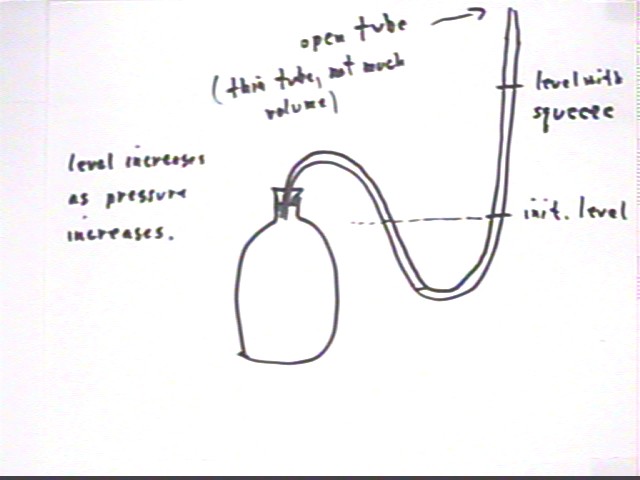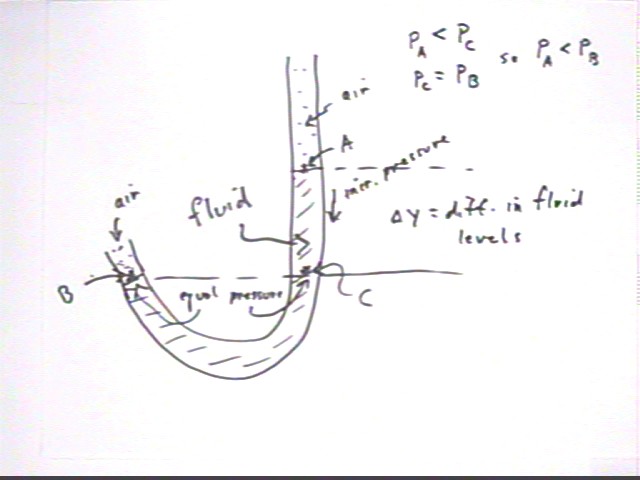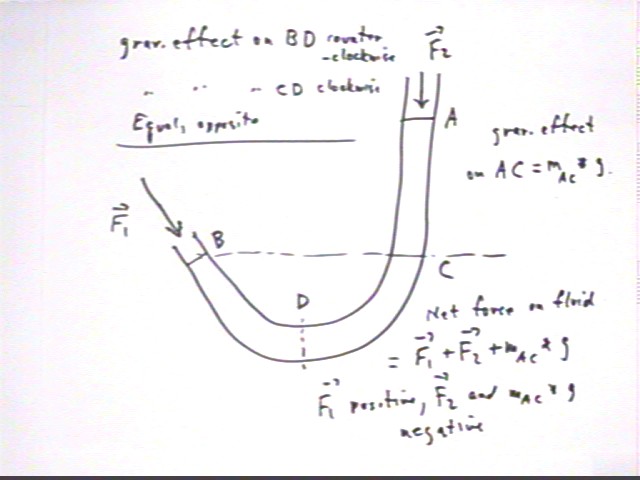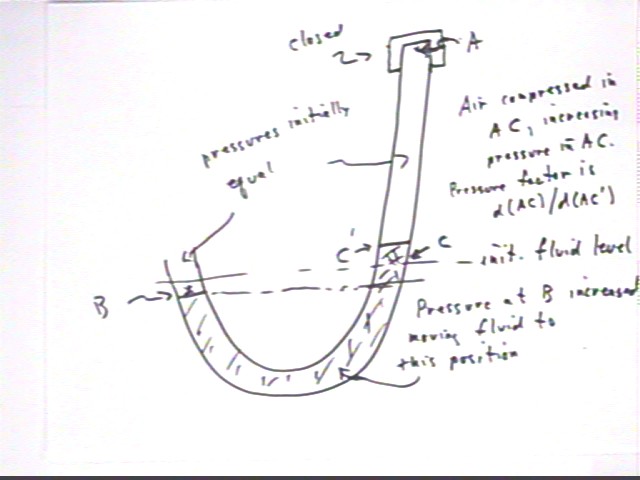U tube analysis using Newton's Laws
The situations observed during the preceding class are
summarized below, with the figure representing a column of alcohol in a thin U tube
(inner diameter 1/8 inch) partially filled with alcohol and extending from a sealed
3-liter bottle, represented by the figure below.
- When the top of the tube was open to the atmosphere a significant but
modest squeeze of the bottle raised the level of the alcohol about half a meter.
- When the top of the tube was closed a hard squeeze barely changed the
level of the alcohol.
- When the last half-meter of the tube was nearly level and open to the
atmosphere the temperature change induced by the instructor's palm in contact with, but
not squeezing, the container apparently caused the alcohol column to move a few
centimeters within a minute or so.

The fluid in the tube initially had equal pressures in the
'bottle side' (point B) and the 'open side' (the vertical part of the tube,
which includes point A). The initial fluid level was the same in both
sides of the tube; this initial level is not represented in the
figure.
When the bottle was squeezed a bit we found that the fluid was
displaced in the counterclockwise direction so that the level in the vertical
part of the tube, open to the atmosphere, is greater than that in the 'bottle
side' of the tube.
We wish to compare the pressure at A with that at B.
Call these pressures PA and PB.
- The pressure in a continuous stationary fluid is the same
at equal depths, so the pressure is the same at B and C.
- The pressure in a continuous stationary fluid increases
with increasing depth, so the pressure increases as we move 'down' the
vertical tube from point A to point B.
- We therefore conclude that the pressure at A is less than
that at C, and that the pressure at C is the same as that at B.
- From this we conclude that PA < PB.
This conclusion is consistent with our intuition that by
squeezing the bottle we increased the pressure in the air inside the
bottle. Note that the pressure at point B, where the air in the bottle
meets the fluid in the tube, is the same for the air as for the
fluid.

The situation can be analyzed from the point of view of
Newton's Second Law. Since the fluid is stationary we conclude that the
net force on the fluid is zero. There is a force F1 exerted on the fluid
at point B, tending to accelerate the system in the counterclockwise (positive)
direction, and a force F2 at point A which tends to accelerate the system in the
clockwise (negative) direction.
- If F1 and F2 were the only forces involved they would have
to be equal and opposite, since the fluid is stationary.
- However there are also gravitational and normal forces
acting on the fluid.
- The total gravitational and normal force acting in
the segment BD is equal and opposite to the total gravitational and normal
force acting on the fluid in segment CD, so the fluid in BC makes zero
contribution to the net force.
- The gravitational force exerted on the fluid in segment AC
is mAC * g, where mAC is the mass of the fluid in segment AC. If the
tube is vertical there is no normal force in this segment and we see that
the net force on the fluid is F1 + F2 + mAC * g, where
the boldface characters indicate vector quantities.
- Since the net force is zero, and since F1 acts in the
negative direction, we conclude that - F1 + F2 + mAC g = 0 so that F1 = F2 +
mAC g. Note that now F1, F2 and g are not boldfaced and hence indicate
the magnitudes of the quantities.
- Since F1 = F2 + mAC g we see that F1 must be greater than
F2, consistent with the idea that the pressure at point B is greater than
that at point A.

In the situation depicted below the vertical tube is closed at
point A. We consider what we observed when the bottle was squeezed and the
tube was closed, which was that a much harder squeeze than before resulted in
only a small change in the position of the fluid.
- The change in the position of the fluid changes the fluid
level from the initial level C, where the level was the same in both sides
of the tube, to level C '. This shortens the column of air originally
confined to AC.
- Since the cross-sectional area of the tube is constant, the
volume ratio of the vertical column of air is therefore d(AC ' ) / d(AC),
where d(XY) stands for the distance between points X and Y.
- The pressure of the shorter column is therefore d(AC) /
d(AC ' ) times the original pressure.
Noting that the difference in level B and level C ' is small
compared to the difference that occurred with the open tube, and that the
squeeze necessary to create the large difference in the open tube was much
less than the squeeze used to get the small difference with the closed tube, we
conclude that the pressure difference between level C ' and level B is much
smaller than the pressure difference due to the compression of the air in
segment AC.





